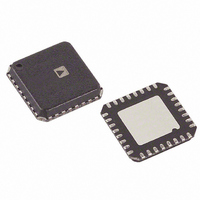ADP1829ACPZ-R7 Analog Devices Inc, ADP1829ACPZ-R7 Datasheet - Page 20

ADP1829ACPZ-R7
Manufacturer Part Number
ADP1829ACPZ-R7
Description
IC BUCK SYNC ADJ 100uA 32LFCSP
Manufacturer
Analog Devices Inc
Type
Step-Down (Buck)r
Datasheet
1.ADP1829ACPZ-R7.pdf
(32 pages)
Specifications of ADP1829ACPZ-R7
Internal Switch(s)
No
Synchronous Rectifier
Yes
Number Of Outputs
2
Voltage - Output
0.6 ~ 15 V
Current - Output
100µA
Frequency - Switching
300kHz, 600kHz
Voltage - Input
3 ~ 18 V
Operating Temperature
-40°C ~ 125°C
Mounting Type
Surface Mount
Package / Case
32-LFCSP
Power - Output
1W
Primary Input Voltage
20V
No. Of Outputs
2
Output Voltage
17V
No. Of Pins
32
Operating Temperature Range
-40°C To +85°C
Msl
MSL 3 - 168 Hours
Frequency Max
1MHz
Termination Type
SMD
Lead Free Status / RoHS Status
Lead free / RoHS Compliant
For Use With
ADP1829-EVALZ - BOARD EVALUATION ADP1829
Lead Free Status / RoHS Status
Lead free / RoHS Compliant, Lead free / RoHS Compliant
Other names
ADP1829ACPZ-R7TR
ADP1829
The rest of the system gain is needed to reach 0 dB at crossover.
The total gain of the system, therefore, is given by
where:
A
A
the ESR zero.
A
Additionally, the phase of the system must be brought back up
to guarantee stability. Note from the bode plot of the filter that
the LC contributes −180° of phase shift. Additionally, because
the error amplifier is an integrator at low frequency, it contrib-
utes an initial −90°. Therefore, before adding compensation or
accounting for the ESR zero, the system is already down −270°.
To avoid loop inversion at crossover, or −180° phase shift, a
good initial practical design is to require a phase margin of 60°,
which is therefore an overall phase loss of −120° from the initial
low frequency dc phase. The goal of the compensation is to
boost the phase back up from −270° to −120° at crossover.
The two common compensation schemes used are sometimes
referred to as Type II or Type III compensation, depending on
whether the compensation design includes two or three poles.
(Dominant-pole compensations, or single-pole compensation,
is referred to as Type I compensation, but unfortunately, it is not
very useful for dealing successfully with switching regulators.)
If the zero produced by the ESR of the output capacitor provides
sufficient phase boost at crossover, Type II compensation is
adequate. If the phase boost produced by the ESR of the output
capacitor is not sufficient, another zero is added to the
compensation network, and thus, Type III is used.
In Figure 27, the location of the ESR zero corner frequency
gives significantly different net phase at the crossover frequency.
Use the following guidelines for selecting between Type II and
Type III compensators:
If
If
MOD
FILTER
COMP
f
f
ESRZ
ESRZ
A
is the gain of the PWM modulator.
is the gain of the compensated error amplifier.
T
is the gain of the LC filter including the effects of
= A
≤
>
f
f
CO
2
MOD
CO
2
, use Type II compensation.
, use Type III compensation.
+ A
FILTER
+ A
COMP
(26)
Rev. B | Page 20 of 32
The following equations were used for the calculation of the
compensation components as shown in Figure 28 and Figure 29:
where:
f
f
f
f
PHASE
Z1
Z2
P1
P2
GAIN
is the zero produced in the Type II compensation.
is the zero produced in the Type III compensation.
is the pole produced in the Type II compensation.
in the pole produced in the Type III compensation.
f
f
f
f
Z1
Z2
P1
P2
0dB
0°
–90°
–180°
=
=
=
=
PHASE CONTRIBUTION AT CROSSOVER
–40dB/dec
–20dB/dec
2
2
2
2
π
π
π
π
OF VARIOUS ESR ZERO CORNERS
R
R
C
R
1
Z
Z
FF
LC FILTER BODE PLOT
FF
1
f
C
LC
C
C
(
I
R
1
C
I
FF
f
Figure 27. LC Filter Bode Plot
ESR1
TOP
1
I
+
C
C
HF
f
+
ESR2
HF
R
FF
f
ESR3
)
f
CO
Φ
Φ
Φ
1
2
3
f
SW
FREQUENCY
(27)
(28)
(29)
(30)












